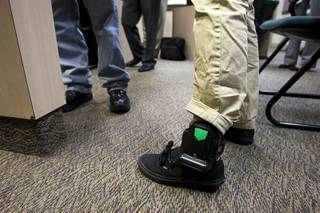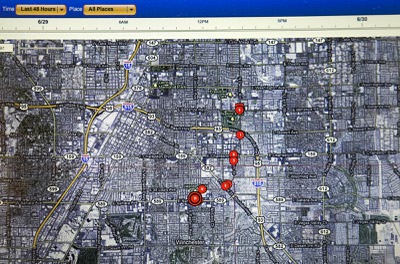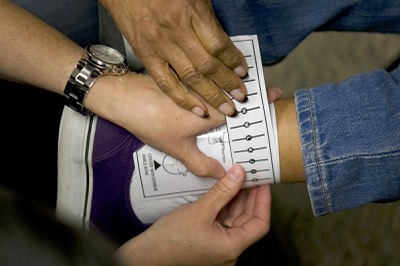
A probation officer installs a new SecureAlert GPS ankle-bracelet on a juvenile offender in a courtroom at the Family Court building Thursday, June 30, 2011.
Tuesday, July 12, 2011 | 2 a.m.
Sun Coverage
It’s probably not a fashion accessory the sharply dressed young man standing inside a juvenile courtroom wanted: a 2-pound ankle bracelet with a steel-lined cuff attached to his right leg.
But it certainly beats the drab prison attire worn by offenders in the Juvenile Detention Center. The 20-year-old, who committed an offense as a juvenile, smiled sheepishly as he stood and inspected the black bulge wrapping his ankle.
“Read this. Understand it. Know it,” juvenile probation officer Paul Roberson told the young man as he handed him a yellow paper detailing proper care and rules for wearing the GPS-enabled ankle bracelet.
With that, officials bid him good luck and ushered a new juvenile offender into the courtroom for the same series of measurements, screwing and adjustments resulting in the fitted monitoring system.
The process continued until about 20 juveniles, mostly teens, received the SecureAlert ankle bracelets, a new monitoring system implemented this month that Juvenile Justice Services officials hope lowers Clark County’s youth detention center population while retaining safety in the community.
The ankle bracelets replace an old GPS-monitoring system that served fewer juveniles and used flimsier ankle cuffs, translating to more headaches for probation officers who sometimes found themselves tracking a unit to a roadside bush.
“We’ve had some issues in the past with kids cutting them off and throwing them away,” said Fritz Reese, Clark County’s Juvenile Justice Services director.
The new ankle bracelets, described by officials as “virtually indestructible,” aim to solve that issue, in addition to providing the latest technology: built-in cellphones to allow communication between supervisors and offenders, minute-by-minute tracking and warning signals that can be activated if an offender leaves or enters a specific area, Reese said.
“What this provides is an opportunity to give assurance to the court and community that we’re using the latest technology,” Reese said.
And it’s more cost effective for the county, he added. It costs the county about $245 per day to house offenders in the Juvenile Detention Center, the 192-bed facility on North Pecos Road and connected to the Family Court building.
The center houses about 180 to 185 youths, operating near capacity, said Marc Humphries, center manager.
By increasing the number of juveniles wearing the ankle bracelets from 45 to 110, officials hope to reallocate staff to provide all-week coverage and timely responses by probation officers to any violations.
Juvenile Justice Services budgeted $250,000 this year for the monitoring system, funded by court fines and existing funds allocated to the probation budget, Reese said.
“As you drive down your population in detention, you free up staff to do community supervision,” he said.
The reallocation will save money in the long run, but officials haven’t estimated the exact amount, he added.
Money, however, was just one factor influencing officials’ decision to adopt the system. It also falls in line with the community-based approach of Juvenile Justice, which Reese said studies have proved to be more effective in reducing recidivism rates.
“Youth respond better to being kept in the community and being involved in positive community endeavors,” he said.
Of course, not all offenders qualify for the program. A judge makes that decision based on the seriousness of the offense and behavior of the child or teen, most of whom would wear the ankle bracelets between the time of their arrest and court date.
On a recent afternoon, juvenile probation officer Angela Quagliana and Juvenile Justice Services assistant Stephen Mathews made their daily tour of house visits to check on juveniles monitored by the system. It indicated that a 16-year-old under house arrest for drug-related charges had been tampering with his ankle bracelet.
Quagliana checked his device but didn’t see anything suspicious. The teen admitted to fiddling with it while trying to plug it in to charge.
“If you’re doing a lot of movement with it, it thinks you’re messing around with it,” she warned him. “We don’t want any of that.”
Under the old system, Quagliana started her day with the time-intensive task of checking for violations by offenders. Now, the Utah-based SecureAlert system’s 24-hour call center immediately alerts probation officers or supervisors — wherever they are — if it’s unable to reach an offender who has left a designated area or if other violations occur.
So far, officials said they have seen fewer offenders attempt to stray from home or other approved locations. When one teen did leave an area, Patricia Iurato, the detention review and release program supervisor, gave probation officers minute-by-minute directions as she tracked the offender’s whereabouts via the Google map-based monitoring system.
“I set off the alarm, and the kid came running out ... into their arms,” Iurato said. “It worked pretty well.”
The premise is simple: If the juvenile offenders violate the program, they face new charges.
Part of the judges’ rationale in ordering GPS monitoring is to determine whether the teen offenders can follow the rules before their sentencing, Mathews said.
“We tell them right off the bat that we’re there to help them get through the program,” he said, “but ultimately it’s their decision.”
Officials hope to have the extra staff for the community-based monitoring in place by August. At that point, more juvenile offenders likely will receive the GPS-enabled ankle bracelets.
“This is the highest level of response we’ve had with these new units,” Iurato said, referring to how quickly probation officers can address violations. “It seems to be working well so far.”




Join the Discussion:
Check this out for a full explanation of our conversion to the LiveFyre commenting system and instructions on how to sign up for an account.
Full comments policy